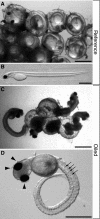Unexpectedly high mortality in Pacific herring embryos exposed to the 2007 Cosco Busan oil spill in San Francisco Bay
- PMID: 22203989
- PMCID: PMC3258612
- DOI: 10.1073/pnas.1108884109
Unexpectedly high mortality in Pacific herring embryos exposed to the 2007 Cosco Busan oil spill in San Francisco Bay
Abstract
In November 2007, the container ship Cosco Busan released 54,000 gallons of bunker fuel oil into San Francisco Bay. The accident oiled shoreline near spawning habitats for the largest population of Pacific herring on the west coast of the continental United States. We assessed the health and viability of herring embryos from oiled and unoiled locations that were either deposited by natural spawning or incubated in subtidal cages. Three months after the spill, caged embryos at oiled sites showed sublethal cardiac toxicity, as expected from exposure to oil-derived polycyclic aromatic compounds (PACs). By contrast, embryos from the adjacent and shallower intertidal zone showed unexpectedly high rates of tissue necrosis and lethality unrelated to cardiotoxicity. No toxicity was observed in embryos from unoiled sites. Patterns of PACs at oiled sites were consistent with oil exposure against a background of urban sources, although tissue concentrations were lower than expected to cause lethality. Embryos sampled 2 y later from oiled sites showed modest sublethal cardiotoxicity but no elevated necrosis or mortality. Bunker oil contains the chemically uncharacterized remains of crude oil refinement, and one or more of these unidentified chemicals likely interacted with natural sunlight in the intertidal zone to kill herring embryos. This reveals an important discrepancy between the resolving power of current forensic analytical chemistry and biological responses of keystone ecological species in oiled habitats. Nevertheless, we successfully delineated the biological impacts of an oil spill in an urbanized coastal estuary with an overlapping backdrop of atmospheric, vessel, and land-based sources of PAC pollution.
Conflict of interest statement
The authors declare no conflict of interest.
Figures






Similar articles
-
Potent phototoxicity of marine bunker oil to translucent herring embryos after prolonged weathering.PLoS One. 2012;7(2):e30116. doi: 10.1371/journal.pone.0030116. Epub 2012 Feb 1. PLoS One. 2012. PMID: 22312421 Free PMC article.
-
Urban stormwater and crude oil injury pathways converge on the developing heart of a shore-spawning marine forage fish.Aquat Toxicol. 2020 Dec;229:105654. doi: 10.1016/j.aquatox.2020.105654. Epub 2020 Oct 11. Aquat Toxicol. 2020. PMID: 33161306
-
Deepwater Horizon crude oil impacts the developing hearts of large predatory pelagic fish.Proc Natl Acad Sci U S A. 2014 Apr 15;111(15):E1510-8. doi: 10.1073/pnas.1320950111. Epub 2014 Mar 24. Proc Natl Acad Sci U S A. 2014. PMID: 24706825 Free PMC article.
-
The importance of both potency and mechanism in dose-response analysis: an example from exposure of Pacific herring (Clupea pallasi) embryos to low concentrations of weathered crude oil.Mar Pollut Bull. 2013 Feb 15;67(1-2):7-15. doi: 10.1016/j.marpolbul.2012.12.014. Epub 2013 Jan 12. Mar Pollut Bull. 2013. PMID: 23321595 Review.
-
The influence of heart developmental anatomy on cardiotoxicity-based adverse outcome pathways in fish.Aquat Toxicol. 2016 Aug;177:515-25. doi: 10.1016/j.aquatox.2016.06.016. Epub 2016 Jun 21. Aquat Toxicol. 2016. PMID: 27447099 Review.
Cited by
-
Potent phototoxicity of marine bunker oil to translucent herring embryos after prolonged weathering.PLoS One. 2012;7(2):e30116. doi: 10.1371/journal.pone.0030116. Epub 2012 Feb 1. PLoS One. 2012. PMID: 22312421 Free PMC article.
-
Interactions between oil-spill pollutants and natural stressors can compound ecotoxicological effects.Integr Comp Biol. 2013 Oct;53(4):635-47. doi: 10.1093/icb/ict080. Epub 2013 Jul 10. Integr Comp Biol. 2013. PMID: 23842611 Free PMC article. Review.
-
Influence of crude oil exposure on cardiac function and thermal tolerance of juvenile rainbow trout and European sea bass.Environ Sci Pollut Res Int. 2017 Aug;24(24):19624-19634. doi: 10.1007/s11356-017-9609-x. Epub 2017 Jul 5. Environ Sci Pollut Res Int. 2017. PMID: 28681300
-
Recommendations for advancing test protocols examining the photo-induced toxicity of petroleum and polycyclic aromatic compounds.Aquat Toxicol. 2023 Mar;256:106390. doi: 10.1016/j.aquatox.2022.106390. Epub 2023 Jan 5. Aquat Toxicol. 2023. PMID: 36709615 Free PMC article.
-
Combined effects of elevated temperature and Deepwater Horizon oil exposure on the cardiac performance of larval mahi-mahi, Coryphaena hippurus.PLoS One. 2018 Oct 17;13(10):e0203949. doi: 10.1371/journal.pone.0203949. eCollection 2018. PLoS One. 2018. PMID: 30332409 Free PMC article.
References
-
- Watters DL, Brown HM, Griffin FJ, Larson EJ, Cherr GN. Pacific herring spawning grounds in San Francisco Bay: 1973–2000. In: Feyrer F, Brown LR, Brown RL, Orsi JJ, editors. Early Life History of Fishes in the San Francisco Estuary and Watershed. Bethesda, MD: American Fisheries Society; 2004. pp. 3–36.
-
- US Coast Guard Incident Specific Preparedness Review (ISPR) M/V Cosco Busan Oil Spill in San Francisco Bay: Report on Initial Response Phase, 11 January 2008. 2008. Available at www.uscg.mil/foia/CoscoBuscan/CoscoBusanISPRFinalx.pdf.
-
- Brown ED, et al. Injury to the early life history stages of Pacific herring in Prince William Sound after the Exxon Valdez oil spill. In: Rice SD, Spies RB, Wolfe DA, Wright BA, editors. Proceedings of the Exxon Valdez Oil Spill Symposium. Vol. 18. Bethesda, MD: American Fisheries Society; 1996. pp. 448–462.
-
- Hose JE, et al. Sublethal effects of the Exxon Valdez oil spill on herring embryos and larvae: Morphological, cytogenetic, and histopathological assessments, 1989–1991. Can J Fish Aquat Sci. 1996;53:2355–2365.
-
- McGurk MD, Brown ED. Egg-larval mortality of Pacific herring in Prince William Sound, Alaska, after the Exxon Valdez oil spill. Can J Fish Aquat Sci. 1996;53:2343–2354.

